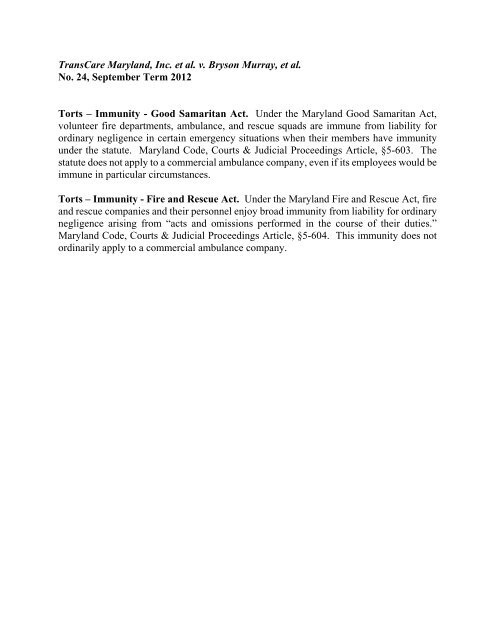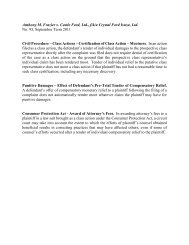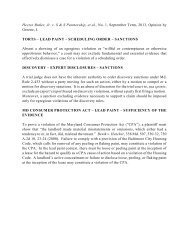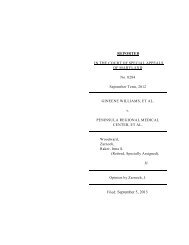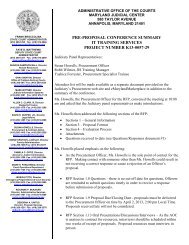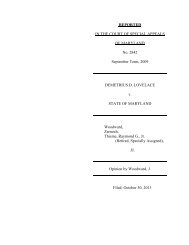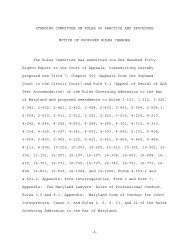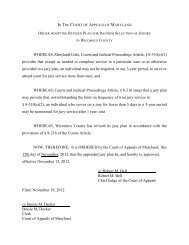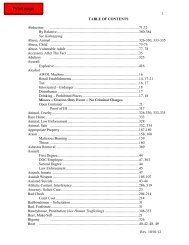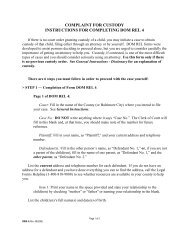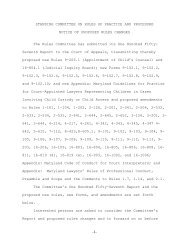24/12 - Maryland Courts
24/12 - Maryland Courts
24/12 - Maryland Courts
You also want an ePaper? Increase the reach of your titles
YUMPU automatically turns print PDFs into web optimized ePapers that Google loves.
TransCare <strong>Maryland</strong>, Inc. et al. v. Bryson Murray, et al.<br />
No. <strong>24</strong>, September Term 20<strong>12</strong><br />
Torts – Immunity - Good Samaritan Act. Under the <strong>Maryland</strong> Good Samaritan Act,<br />
volunteer fire departments, ambulance, and rescue squads are immune from liability for<br />
ordinary negligence in certain emergency situations when their members have immunity<br />
under the statute. <strong>Maryland</strong> Code, <strong>Courts</strong> & Judicial Proceedings Article, §5-603. The<br />
statute does not apply to a commercial ambulance company, even if its employees would be<br />
immune in particular circumstances.<br />
Torts – Immunity - Fire and Rescue Act. Under the <strong>Maryland</strong> Fire and Rescue Act, fire<br />
and rescue companies and their personnel enjoy broad immunity from liability for ordinary<br />
negligence arising from “acts and omissions performed in the course of their duties.”<br />
<strong>Maryland</strong> Code, <strong>Courts</strong> & Judicial Proceedings Article, §5-604. This immunity does not<br />
ordinarily apply to a commercial ambulance company.
IN THE COURT OF APPEALS<br />
OF MARYLAND<br />
No. <strong>24</strong><br />
September Term, 20<strong>12</strong><br />
TransCare <strong>Maryland</strong>., Inc., et al.<br />
v.<br />
Bryson Murray, et al.<br />
Bell, C.J.<br />
Harrell<br />
Greene<br />
Adkins<br />
Barbera<br />
McDonald<br />
Wilner (retired, specially<br />
assigned)<br />
JJ.<br />
Opinion by McDonald, J.<br />
Filed: April 22, 2013
In the parable of the Good Samaritan, a man on the way from Jerusalem to Jericho is<br />
robbed, beaten, and left for dead. Two passers-by of significant social and religious status<br />
see the injured man, but choose to cross to the other side of the road. A third traveler of less<br />
repute, a Samaritan, comes to the man’s aid, takes him to an inn, tends to him through the<br />
night, and then pays the innkeeper the next morning to continue the man’s care.<br />
We do not know from the parable whether the fear of civil liability discouraged the<br />
first two passers-by from intervening. In modern-day <strong>Maryland</strong>, a State law known as the<br />
Good Samaritan Act seeks to remove that disincentive, particularly for individuals who have<br />
the knowledge and skills to provide useful medical assistance at an emergency, by granting<br />
those individuals immunity from liability should something go awry. In some instances that<br />
immunity extends to an entity when its personnel provide emergency aid.<br />
Another source of immunity – sovereign immunity – derives from the ancient tenet<br />
that “the King can do no wrong.” 1<br />
Public agencies and employees, including first<br />
responders, have long enjoyed a broad qualified immunity from liability as an aspect of<br />
sovereign or governmental immunity. A State statute, popularly known as the Fire and<br />
Rescue Act, extends similarly broad immunity to fire companies, rescue companies, and their<br />
personnel for “any act or omission in the course of performing their duties.”<br />
These two statutes – the one potentially applicable to a broad class of actors but<br />
focused on emergency situations, the other applicable to a narrower class but broader in the<br />
scope of the immunity it confers – provide overlapping protection to some extent. This case<br />
1 Katz v. WSSC, 284 Md. 503, 507, 397 A.2d 1027 (1979).
concerns whether one, or both, of these statutes necessarily relieves a commercial ambulance<br />
company of liability for the allegedly negligent actions of one of its employees in providing<br />
assistance to a patient when an emergency arose while the employee was in training. We<br />
hold that they do not.<br />
Background<br />
The Transport of Bryson Murray<br />
On November 15, 2007, Respondent Bryson Murray, 2 a minor who was suffering<br />
from congestion and was having trouble breathing, was taken to Easton Memorial Hospital<br />
(“Easton Memorial”) in Talbot County. 3<br />
At the hospital he was fitted with an endotracheal<br />
breathing tube. Because Easton Memorial was not equipped to handle intubated children,<br />
hospital officials sought to transfer him to the pediatric intensive care unit at the Medical<br />
Center of the University of <strong>Maryland</strong> Medical System (“UMMS”) in Baltimore.<br />
UMMS arranged for PHI Air Medical to carry out the transport by helicopter. Present<br />
on the helicopter was a flight paramedic team that included a UMMS pediatric intensive-care<br />
nurse, a PHI flight paramedic, and a PHI flight nurse. Also present was Chris Barbour, 4 a<br />
2 We will refer to Bryson Murray in this opinion by his first name to distinguish him<br />
from his mother, Karen Murray, who is also a Respondent in this case. We will refer to them<br />
collectively as “the Murrays.”<br />
3 This background is drawn from the allegations in the complaint that initiated this<br />
action, as well as other undisputed facts established in the record.<br />
4 The complaint spells the last name as “Barber.” In their briefs, the parties have<br />
consistently spelled the name as “Barbour,” which we presume to be the correct spelling.<br />
2
paramedic employed by Petitioner TransCare 5 who had been invited to ride along by the<br />
UMMS nurse (with PHI’s permission) for orientation purposes. TransCare, a licensed<br />
commercial ground ambulance transport company, was under contract with UMMS to<br />
provide ground ambulance services for patients between the Medical Center and area<br />
hospitals. 6<br />
Mr. Barbour was a licensed emergency medical technician - paramedic.<br />
After the helicopter arrived at Easton Memorial, Mr. Barbour set up equipment and<br />
the team placed Bryson on the aircraft. Shortly after take-off, however, Bryson’s heart rate<br />
and oxygen blood level began to drop, because, according to the allegations in the complaint,<br />
the endotracheal tube had become dislodged and was blocking his airway. Members of the<br />
flight team searched for a pediatric air mask to restore Bryson’s breathing, but were unable<br />
to locate it. The helicopter then landed at Bay Bridge Airport in Stevensville, where the<br />
flight paramedic retrieved the mask from its storage compartment and Bryson was<br />
reintubated. Bryson’s cardiac activity returned to normal and the helicopter completed its<br />
trip to the Medical Center.<br />
5 We use the designation “TransCare” to refer collectively to TransCare Corporation<br />
and its subsidiary TransCare <strong>Maryland</strong>, Inc., both of which were named as defendants in the<br />
complaint and both of which are Petitioners in this Court.<br />
6 TransCare does not operate helicopters or typically employ personnel to participate<br />
in air medical transportation.<br />
3
The Murrays’ Negligence Action<br />
Complaint<br />
Bryson, by his mother, Karen Murray, subsequently filed a complaint against<br />
TransCare alleging medical malpractice on the basis that its employee, Mr. Barbour, had<br />
failed to provide the requisite standard of care and that TransCare was vicariously<br />
responsible under the principle of respondeat superior. 7 According to the complaint, Bryson<br />
suffered hypoxic brain injury due to alleged acts and omissions of Mr. Barbour during the<br />
helicopter transport and, as a result, is blind, deaf, and mentally disabled. The complaint did<br />
not name Mr. Barbour individually as a defendant. 8<br />
Summary Judgment Motion<br />
7 This Court has recently described the doctrine of respondeat superior:<br />
Litigants may invoke the doctrine of respondeat superior<br />
as a means of holding an employer, corporate or otherwise,<br />
vicariously liable for the tortious conduct of an employee, where<br />
it has been shown that the employee was acting within the scope<br />
of the employment relationship at that time. On a successful<br />
claim under the doctrine of respondeat superior, an employer<br />
will be held jointly and severally liable for the tortious acts<br />
committed by its employee. For an employee’s tortious acts to<br />
be considered within the scope of employment, the acts must<br />
have been in furtherance of the employer’s business and<br />
authorized by the employer.<br />
S. Mgmt. Corp. v. Taha, 378 Md. 461, 480-81, 836 A.2d 627 (2003).<br />
8 The Murrays had earlier also asserted claims against PHI Air Medical and UMMS,<br />
which had been resolved by the time the complaint was filed.<br />
4
TransCare moved for summary judgment, arguing that it was immune from liability<br />
under both the Good Samaritan Act and the Fire and Rescue Act. The Circuit Court for<br />
Talbot County 9 was initially persuaded that there were disputes of material fact as to<br />
TransCare’s corporate relationship with the other medical providers involved and as to<br />
whether it had received a “fee or compensation” that would preclude application of the Good<br />
Samaritan Act. The Circuit Court also tentatively concluded that the Fire and Rescue Act<br />
did not apply to a commercial ambulance company such as TransCare. Accordingly, the<br />
Circuit Court initially denied TransCare’s motion for summary judgment based on those<br />
immunity provisions.<br />
TransCare thereafter filed a motion for reconsideration, submitting two affidavits that<br />
established the company’s independent corporate status and described its billing practices.<br />
Following a hearing on that motion, the Circuit Court concluded that there were no remaining<br />
disputes of material fact and that TransCare was immune under both the Good Samaritan Act<br />
and the Fire and Rescue Act. It therefore granted summary judgment in favor of TransCare.<br />
Appeal<br />
The Murrays appealed and the Court of Special Appeals reversed, holding that neither<br />
statute applied to a private, for-profit ambulance company. 203 Md. App. 172, 37 A.3d 987<br />
(20<strong>12</strong>). TransCare petitioned this Court for certiorari. We granted the petition to determine<br />
9 The complaint was initially filed in the Circuit Court for Baltimore City but, upon<br />
motion by TransCare, was transferred to the Circuit Court for Talbot County on the ground<br />
that the latter court was the more appropriate venue under the doctrine of forum non<br />
conveniens.<br />
5
whether either the Good Samaritan Act or the Fire and Rescue Act relieves a commercial<br />
ambulance company of civil liability for the alleged negligence of an employee committed<br />
when an emergency arises during a transfer of a patient between medical facilities. 10<br />
Standard of Review<br />
Whether summary judgment was properly granted is a question of law; we review the<br />
Circuit Court’s decision to determine whether it was legally correct. Walk v. Hartford Cas.<br />
Ins. Co., 382 Md. 1, 14, 852 A.2d 98 (2004). Like the Circuit Court, we view the record in<br />
the light most favorable to the non-moving party to ascertain whether there is a dispute of<br />
material fact and, if not, whether the moving party is entitled to judgment as a matter of law.<br />
Jurgensen v. New Phx. Atl. Condo. Council of Unit Owners, 380 Md. 106, 114, 843 A.2d 865<br />
(2004).<br />
Analysis<br />
In order to assess TransCare’s claims of immunity, we must construe two statutes –<br />
the Good Samaritan Act and the Fire and Rescue Act. This Court has frequently reiterated<br />
the principles that guide statutory interpretation, which we summarize as follows:<br />
• give effect to legislative intent<br />
• look first to the “ordinary, plain meaning” of the language<br />
• do not add or delete language<br />
• do not apply forced or subtle interpretations<br />
10 The Court of Special Appeals also affirmed the decision to transfer the case from<br />
Baltimore City to Talbot County. 203 Md. App. at 187-97. That ruling is not before us.<br />
6
• keep in mind the statutory context<br />
• consider the purpose, aim, or policy of the Legislature<br />
• avoid constructions inconsistent with common sense<br />
• presume that each section is to work harmoniously with others<br />
See, e.g., Willis v. Montgomery County, 415 Md. 523, 536-37, 3 A.3d 448 (2010).<br />
Whether TransCare Has Immunity under the Good Samaritan Act<br />
Good Samaritan Laws<br />
Under the common law, there is no general duty to provide assistance to those in peril.<br />
See Prosser, Law of Torts (4 th ed.1971) §56 at 340-43 (“the law has persistently refused to<br />
recognize the moral obligation, of common decency and common humanity, to come to the<br />
aid of another human being who is in danger...”). Moreover, under general principles of tort<br />
law, one who voluntarily chooses to aid another owes that person a duty of care; a failure to<br />
exercise such care may result in legal liability. See Remsburg v. Montgomery, 376 Md. 568,<br />
589-90, 831 A.2d 18 (2003); see also 57A Am. Jur. 2d Negligence §104 (20<strong>12</strong>); Restatement<br />
2d of Torts, §§323, 3<strong>24</strong>. This risk of potential liability led to the unsatisfactory result that<br />
health care professionals capable and willing to provide emergency medical services had (in<br />
theory, at least) a disincentive to do so. See Silver, The Duty to Rescue: A Reexamination<br />
and Proposal, 26 Wm. & Mary L. Rev. 423, 428 (1985).<br />
7
Beginning in California in 1959, 11 legislatures in every state enacted laws designed<br />
to eliminate this disincentive and to encourage medical professionals (and, often, volunteers<br />
in general) to provide emergency assistance by granting them immunity from liability for<br />
ordinary negligence. Silver, supra, 26 Wm. & Mary L. Rev. at 427-28. The <strong>Maryland</strong><br />
General Assembly first enacted such a statute in 1963. Chapter 65, Laws of <strong>Maryland</strong> 1963.<br />
From the outset, such laws have generally been labeled the “Good Samaritan Act” or “Good<br />
Samaritan Law,” both in <strong>Maryland</strong> and elsewhere. See Annotation, Construction and<br />
Application of “Good Samaritan” Statutes, 68 ALR 4 th 294 (20<strong>12</strong>); 64 Opinions of the<br />
Attorney General 169 (1979).<br />
<strong>Maryland</strong> Good Samaritan Act<br />
Pertinent to this case, the <strong>Maryland</strong> Good Samaritan Act provides immunity to<br />
specified individuals and entities from liability for ordinary negligence that occurs in<br />
connection with assistance or medical care rendered without fee or other compensation at the<br />
scene of an emergency or in transit to a medical facility. <strong>12</strong> The statute currently provides as<br />
follows:<br />
11 Cal. Bus. & Prof. Code §2144 (1962), later recodified as §2395 (relieving health<br />
care providers rendering emergency aid from the standard duty of care and providing that<br />
only those who are wilfully negligent or act in bad faith face liability). See Franklin,<br />
Vermont Requires Rescue: A Comment, 25 Stan. L. Rev. 51, 52 (1972).<br />
<strong>12</strong> The statute also applies to assistance or medical care provided “through<br />
communications with personnel providing emergency assistance,” a provision that does not<br />
appear to be implicated by the facts of this case. <strong>Maryland</strong> Code, <strong>Courts</strong> & Judicial<br />
Proceedings Article, CJ §5-603(a)(3)(iii).<br />
8
(a) A person described in subsection (b) of this section is not<br />
civilly liable for any act or omission in giving any assistance or<br />
medical care, if:<br />
(1) The act or omission is not one of gross negligence;<br />
(2) The assistance or medical care is provided without<br />
fee or other compensation; and<br />
(3) The assistance or medical care is provided:<br />
(i)<br />
(ii)<br />
At the scene of an emergency;<br />
In transit to a medical facility;<br />
(iii) Through communications with personnel<br />
providing emergency assistance.<br />
(b)<br />
Subsection (a) of this section applies to the following:<br />
(1) An individual who is licensed by this State to<br />
provide medical care;<br />
(2) A member of any State, county, municipal, or<br />
volunteer fire department, ambulance and rescue squad, or law<br />
enforcement agency, the National Ski Patrol System, or a<br />
corporate fire department responding to a call outside of its<br />
corporate premises, if the member:<br />
(i) Has completed an American Red Cross<br />
course in advanced first aid and has a current card showing that<br />
status;<br />
(ii) Has completed an equivalent of an<br />
American Red Cross course in advanced first aid, as determined<br />
by the Secretary of Health and Mental Hygiene; or<br />
(iii) Is certified or licensed by this State as an<br />
emergency medical services provider;<br />
9
(3) A volunteer fire department or ambulance and<br />
rescue squad whose members have immunity; and<br />
(4) A corporation when its fire department personnel<br />
are immune under paragraph (2) of this subsection.<br />
(c) An individual who is not covered otherwise by this<br />
section is not civilly liable for any act or omission in providing<br />
assistance or medical aid to a victim at the scene of an<br />
emergency, if:<br />
(1) The assistance or aid is provided in a reasonably<br />
prudent manner;<br />
(2) The assistance or aid is provided without fee or<br />
other compensation;<br />
(3) The individual relinquishes care of the victim<br />
when someone who is licensed or certified by this State to<br />
provide medical care or services becomes available to take<br />
responsibility.<br />
<strong>Maryland</strong> Code, <strong>Courts</strong> and Judicial Proceedings Article (“CJ”) §5-603. 13 TransCare asserts<br />
that it has immunity directly under CJ §5-603(b)(3) as a “volunteer fire department or<br />
ambulance and rescue squad whose members have immunity.” In addition, TransCare argues<br />
that, regardless of whether CJ §5-603(b)(3) directly confers immunity on it, it has immunity<br />
because its employee, Mr. Barbour, has immunity under the statute.<br />
13 In 2008, after the events set forth in the complaint in this case, the Legislature made<br />
certain “stylistic” changes in CJ §5-603(b)(2) and (b)(3) as part of the annual corrective bill.<br />
Chapter 36, §1, Laws of <strong>Maryland</strong> 2008. In particular, that law deleted the phrase “or of”<br />
from before “the National Ski Patrol” in (b)(2), added the word “or” before “law enforcement<br />
agency” in (b)(2), and replaced a comma with the conjunction “or” after “volunteer fire<br />
department” in (b)(3). Neither party has suggested that these changes have any significance<br />
for the decision of this case.<br />
10
CJ §5-603(b)(3) - Text<br />
As TransCare is a commercial ambulance company, the application of CJ §5-<br />
603(b)(3) to it depends, in part, on whether the adjective “volunteer” modifies only “fire<br />
department” or also modifies “ambulance and rescue squad.” If “volunteer” modifies only<br />
“fire department,” TransCare potentially has immunity as an “ambulance squad” (if its<br />
“members” have immunity). If “volunteer” also modifies “ambulance and rescue squad,”<br />
TransCare does not have immunity under this provision (regardless of whether its “members”<br />
or employees have immunity). Either construction of the phrase is grammatically correct;<br />
in light of this ambiguity in meaning, we resort to the statute’s legislative history to discern<br />
its purpose.<br />
CJ §5-603(b)(3) - Legislative history<br />
What is now CJ §5-603(b)(3) was added to the Good Samaritan Act in 1979. Chapter<br />
301, Laws of <strong>Maryland</strong> 1979. 14 To place it in context, however, we must briefly describe the<br />
history of the Good Samaritan Act leading up to that amendment.<br />
When the General Assembly first enacted the Good Samaritan Act in 1963, the statute<br />
applied only to physicians who provided free medical assistance at the scene of an accident. 15<br />
14 The Court of Special Appeals opinion mistakenly attributes what is now CJ §5-<br />
603(b)(3) to a 1982 amendment that added a similar provision relating to corporate fire<br />
departments, now codified at CJ §5-603(b)(4). 203 Md. App. at 207-10.<br />
15 As originally enacted, the statute read in full:<br />
A physician licensed to practice medicine by the Board of<br />
(continued...)<br />
11
The following year, the statute was amended to expand its protection beyond physicians to<br />
include “members of volunteer ambulance and rescue squads ... organized and operated as<br />
a non-profit group.” 16 In 1969, the provision concerning members of ambulance and rescue<br />
squads was amended to include “members or employees” of fire departments; at the same<br />
15 (...continued)<br />
Medical Examiners in the State of <strong>Maryland</strong>, who, in good faith,<br />
renders medical aid, care, not in a hospital, and assistance for<br />
which the physician received no fee or compensation, at the<br />
scene of an accident, shall not be liable for any civil damages as<br />
the result of any professional acts or omissions by him, not<br />
amounting to gross negligence, in rendering such aid, care, and<br />
assistance. The physician shall have a defense against any<br />
action, not amounting to gross negligence, for negligence or<br />
malpractice brought against him because of any professional<br />
acts or omissions in the rendering of such care, aid and<br />
assistance.<br />
Chapter 65, Laws of <strong>Maryland</strong> 1963 then codified at <strong>Maryland</strong> Code, Article 43, §149A.<br />
16 A 1964 amendment recodified the 1963 law as subsection (a) of §149A and added<br />
an additional subsection, as follows:<br />
(b) The members of volunteer ambulance and rescue squads<br />
shall not be liable for damages as provided in subsection (a)<br />
except for gross negligence, and shall have the defense provided<br />
therein, except for gross negligence. In order to be eligible for<br />
the exemption from liability provided in this section, a person<br />
must have completed a basic course of instruction in first aid,<br />
and must be on active duty as a member of a volunteer<br />
ambulance and rescue squad which (1) is a bona fide and<br />
permanent organization, and (2) is organized and operated as a<br />
non-profit group.<br />
Chapter 48, Laws of <strong>Maryland</strong> 1964, then codified as <strong>Maryland</strong> Code, Article 43, §149A(b).<br />
In 1965, the statute was amended to extend immunity to nurses. Chapter 475, Laws of<br />
<strong>Maryland</strong> 1965.<br />
<strong>12</strong>
time, the adjective “volunteer” was deleted. Thus, the immunity extended to “members or<br />
employees of fire departments or ambulance and rescue squads ... organized and operated as<br />
a nonprofit group.” Chapter 616, Laws of <strong>Maryland</strong> 1969. As is evident, although the word<br />
“volunteer” had been eliminated by the 1969 amendment, the statute did not apply to<br />
members or employees of for-profit organizations.<br />
In 1970, in the course of recodifying the statute, the Legislature returned the adjective<br />
“volunteer” to the statute. Chapter 736, Laws of <strong>Maryland</strong> 1970. 17<br />
Although the Good<br />
Samaritan Act was amended in other respects over the next few years, the language<br />
concerning members of ambulance and rescue squads was unaffected until 1976. 18 Despite<br />
the insertion, deletion, and re-insertion of the word “volunteer” before “ambulance and<br />
17 The Good Samaritan Act was recodified by the 1970 law as <strong>Maryland</strong> Code, Article<br />
43, §132. The provision in question then read:<br />
(b) The members of any fire department or volunteer<br />
ambulance and rescue squads shall not be liable for damages as<br />
provided in subsection (a) hereof, if the members completed an<br />
advanced Red Cross or equivalent course in first aid approved<br />
by the Secretary of the Department of Health and Mental<br />
Hygiene and are members of any fire department or a volunteer<br />
ambulance and rescue squad which (1) is a bona fide and<br />
permanent organization and (2) is operated as a nonprofit group.<br />
<strong>Maryland</strong> Code, Article 43, §132(b).<br />
18 See Chapter 736, Laws of <strong>Maryland</strong> 1970 (modifying training requirement); Chapter<br />
266, Laws of <strong>Maryland</strong> 1972 (expanding coverage to members of National Ski Patrol<br />
System); Chapter 503, Laws of <strong>Maryland</strong> 1973 (extending coverage to law enforcement<br />
officers); Chapter 346, Laws of <strong>Maryland</strong> 1974 (extending coverage to persons rendering<br />
emergency assistance at airport).<br />
13
escue squads,” it remained clear that the statute did not extend to members or employees of<br />
for-profit organizations.<br />
In 1976, the Good Samaritan Act was revised in response to advice from the Attorney<br />
General’s Office that an amendment of the Act was necessary to ensure that functions carried<br />
out under the new State Emergency Medical System were covered by the Good Samaritan<br />
Act. See Letter of Assistant Attorney General Paul Walter to R Adams Cowley, M.D.<br />
(October <strong>24</strong>, 1974). That advice did not suggest that the Act needed to be extended to<br />
commercial ambulance companies or other for-profit entities.<br />
The 1976 revision encompassed the entire statute, including the provision concerning<br />
members of fire departments and ambulance and rescue squads. In particular, the description<br />
of the individuals covered by immunity in that provision was changed from “[t]he members<br />
of any fire department or volunteer ambulance and rescue squads ...” to “[a] member of any<br />
State, county, municipal, or volunteer fire department, ambulance and rescue squad...”<br />
Chapters 558, 689, Laws of <strong>Maryland</strong> 1976. The shifting of the adjective “volunteer” within<br />
the introductory phrase, however, did not signify an indirect expansion of the immunity<br />
provision to members of commercial entities. Rather, it simply ensured that the adjective<br />
“volunteer,” together with the adjectives denoting government entities, would apply to fire<br />
departments as well as ambulance and rescue squads. See Tatum v. Gigliotti, 321 Md. 623,<br />
630, 583 A.2d 1062 (1991) (describing the provision as providing immunity for “members<br />
of fire departments and ambulance and rescue squads which may be state, county or<br />
municipal, as well as volunteer”). That conclusion is confirmed by one of the drafters of the<br />
14
1976 bill, who told the Legislature that the language of the provision concerning members<br />
of fire departments and ambulance and rescue squads was meant simply to restate the<br />
existing immunity without substantive change. See Testimony of William E. Hathaway<br />
(January 29, 1976) (“This paragraph provides the same coverage to firemen, ambulance and<br />
rescue personnel and police as is presently provided in [the Good Samaritan Act]”).<br />
The extension of immunity to the entities themselves in addition to their members –<br />
what is now CJ §5-603(b)(3) – was added to this provision three years later. 19 Chapter 301,<br />
Laws of <strong>Maryland</strong> 1979. At that time, the statute provided immunity for members of “any<br />
State, county, municipal or volunteer fire department, ambulance and rescue squad” who<br />
satisfied certain requirements. <strong>Maryland</strong> Code, Article 43, §132(b) (1971 Repl. Vol., 1978<br />
Supp.). As indicated above, this provision had never applied to members of a commercial<br />
entity. The Anne Arundel County government requested a bill, which originally would have<br />
applied only in Anne Arundel County, to extend that immunity to the organization of which<br />
the immune individuals were members – i.e., so that “a volunteer fire department or<br />
ambulance and rescue squad has the same immunity as its members.” Senate Bill 1031<br />
(1979).<br />
A submission to the Legislature by the Anne Arundel County Executive’s office<br />
explained the need for the amendment. It indicated that the County had agreed to provide<br />
19 In the interim, the statute had been amended in other respects not directly pertinent<br />
to the current issue. See Chapter 463, Laws of <strong>Maryland</strong> 1977 (fixing defect in title of 1976<br />
law); Chapter 140, Laws of <strong>Maryland</strong> 1978 (returning National Ski Patrol System to statute).<br />
15
legal representation for all members of volunteer fire departments “and ambulance/rescue<br />
squads” in the county. See Legislation Submitted by the Anne Arundel County Executive,<br />
1979 General Assembly, copy in legislative file for Senate Bill 1031 (1979). It recounted<br />
a recent case in which a volunteer fire department had been named as a defendant in a lawsuit<br />
in addition to the firefighter. The County noted that, while the firefighter was clearly<br />
immune under the Good Samaritan Act, “[t]he volunteer fire department, however, is a<br />
private nonprofit corporation which does not appear to have the statutory immunity which<br />
is bestowed upon its constituent members. We believe the absence of this protection for the<br />
volunteer unit is not in keeping with the spirit and rationale of [the Good Samaritan Act]<br />
since it has the net effect of discouraging the active participation of these units in emergency<br />
situations.” Id. (emphasis added). The bill’s geographical limitation to Anne Arundel<br />
County was ultimately eliminated, making the amendment applicable statewide. No<br />
amendment was made to the substantive language concerning the types of organizations<br />
covered by the immunity. The bill was enacted and codified at that time in Article 43,<br />
§132(b).<br />
There is no indication in the language of the 1979 amendment or its legislative history<br />
of any intent to extend this protection to commercial ambulance companies.<br />
The<br />
amendment keyed the immunity of a “volunteer fire department or ambulance and rescue<br />
squad” to the immunity of its “members” – an odd term to use if the amendment<br />
16
encompassed the employees of a company with stockholders. 20 While the example given by<br />
the county government that proposed the amendment involved a volunteer fire department,<br />
it stated that it had agreed to provide legal representation for the members of<br />
“ambulance/rescue squads” and its purpose for including those organizations in the bill was<br />
the same as stated for the volunteer fire department that had been sued. There is no<br />
suggestion in these materials that the county had decided to provide free legal representation<br />
to the employees of commercial ambulance companies or was seeking to confer a benefit on<br />
those entities. Nor is there any discussion of the potential liability of commercial ambulance<br />
companies. It is clear that the legislation was concerned with expanding immunity to<br />
volunteer, nonprofit entities to remove a disincentive to the provision of their emergency<br />
services. Consistent with this history, a contemporaneous opinion of the Attorney General<br />
construed the term “volunteer” in the statute to modify “ambulance and rescue squad.” 64<br />
Opinions of the Attorney General 175, 176 (1979) (concluding that “the Community Rescue<br />
Service and its members are covered under §132(b) as a “volunteer ... ambulance and rescue<br />
squad”).<br />
20 By contrast, the amendment of the Good Samaritan Act three years later that<br />
extended its protection to corporations with fire departments refers to the “personnel” of<br />
those departments. Chapter 775, Laws of <strong>Maryland</strong> 1982, now codified at CJ 5-603(b)(4).<br />
17
After 1979, the Good Samaritan Act was amended in minor substantive respects not<br />
pertinent to this case 21 and was recodified as part of the <strong>Courts</strong> and Judicial Proceedings<br />
Article in 1982. 22<br />
We agree with the Court of Special Appeals that TransCare, as a for-profit ambulance<br />
company, does not have immunity under CJ §5-603(b)(3) regardless of whether Mr. Barbour<br />
is personally covered by the Act.<br />
Whether TransCare as Employer Necessarily Has Same Immunity as its Employee<br />
TransCare makes a broader argument for immunity under the Good Samaritan Act,<br />
untethered to any of the provisions that specifically confer immunity on corporations or other<br />
organizations. It asserts that, given that its liability is predicated on the actions of its<br />
employee, Mr. Barbour, it cannot be vicariously liable if Mr. Barbour is personally immune<br />
under the Good Samaritan Act. 23<br />
21 For example, a 1982 amendment extended immunity to members of corporate fire<br />
departments – as well as the corporation when the members were immune. Chapter 775,<br />
Laws of <strong>Maryland</strong> 1982.<br />
22 Chapter 770, §4, Laws of <strong>Maryland</strong> 1982. The statute was originally codified in the<br />
<strong>Courts</strong> & Judicial Proceedings Article as CJ §5-309. It was later recodified as CJ §5-603.<br />
Chapter 14, §9, Laws of <strong>Maryland</strong> 1997.<br />
23 TransCare supports this view with its analysis of two Court of Special Appeals<br />
decisions. As TransCare concedes, neither of those decisions expressly addresses its theory<br />
that an employer necessarily has immunity under the Good Samaritan Act if its employee has<br />
immunity. Chase v. Mayor and City Council, <strong>12</strong>6 Md. App. 427, 438, 730 A.2d 239 (1999),<br />
rev’d on other grounds, 360 Md. <strong>12</strong>1, 756 A.2d 987 (2000) (denying immunity under the<br />
Good Samaritan Act to a paramedic employed by a municipal fire department where the city<br />
charged a fee for ambulance service, but stating, “although appellees’ argument apparently<br />
assumes that the immunities for employer and employee are severable, we decline to consider<br />
(continued...)<br />
18
TransCare’s argument is contrary to the general rule on the relationship of employer<br />
immunity to that of an employee. As this Court recently stated: “The principal in an agency<br />
relationship is not entitled to receive immunity simply because the agent is entitled to receive<br />
immunity; the principal must establish an independent basis to receive the benefit of an<br />
immunity shield. ... [U]nless there is an independent source of immunity for the employer or<br />
principal, the cause of action premised on vicarious liability can be brought even if the<br />
employee or agent is entitled to immunity.” D’Aoust v. Diamond, 4<strong>24</strong> Md. 549, 605-7, 36<br />
A.3d 941 (20<strong>12</strong>); see also James v. Prince George’s County, 288 Md. 315, 332, 418 A.2d<br />
1173 (1980) (“As a general rule ... the master remains liable for the servant’s conduct even<br />
though the servant is himself not liable because of a personal immunity”).<br />
TransCare attempts to distinguish D’Aoust on the basis that it concerned common law<br />
immunity rather than statutory immunity. But the Court in D’Aoust specifically noted that<br />
its conclusion applied “to the concept of immunity generally as it relates to causes of action<br />
based on vicarious liability.” D’Aoust, 4<strong>24</strong> Md. at 607. Moreover, in establishing immunity<br />
for individuals by statute, the General Assembly may well contemplate that the individual’s<br />
employer is liable for that individual’s conduct. For example, in the <strong>Maryland</strong> Tort Claims<br />
Act, governmental entities may be liable for the negligent actions of an employee even<br />
23 (...continued)<br />
it further as it is entirely too academic”); McCoy v. Hatmaker, 135 Md. App. 693, 763 A.2d<br />
<strong>12</strong>33 (2000), cert. denied, 364 Md. 141 (2001) (case dismissed against Baltimore City and<br />
employee on the basis of immunity under the Good Samaritan Act and Fire and Rescue Act<br />
without discussion of possible severability).<br />
19
though the Legislature has conferred immunity on the individual employee. See <strong>Maryland</strong><br />
Code, State Government Article, §<strong>12</strong>-101 et. seq.; CJ §5-522. Indeed, if, as a general<br />
principle, an employee’s immunity under the statute relieved the employer of liability, two<br />
provisions of the statute that explicitly confer immunity on specified organizations when the<br />
members or personnel of the organization have immunity – CJ §5-603(b)(3) and (b)(4) –<br />
would be unnecessary. Thus, we are persuaded that an employer does not necessarily have<br />
immunity under the Act simply because its employee has immunity.<br />
Conclusion<br />
TransCare is not a volunteer ambulance and rescue squad and therefore does not<br />
qualify for immunity under CJ §5-603(b)(3). Nor is it shielded from liability under the Act<br />
for the alleged negligence of Mr. Barbour, regardless of whether he individually has<br />
immunity under the statute. <strong>24</strong><br />
Whether TransCare Has Immunity under the Fire and Rescue Act<br />
Fire and Rescue Act - Text<br />
Unlike the Good Samaritan Act, the Fire and Rescue Act confers a broad immunity<br />
on certain organizations without predicating that immunity on the immunity of the<br />
<strong>24</strong> Accordingly, we need not determine issues related to other conditions for immunity<br />
under the Good Samaritan Act – i.e., whether UMMS’s payments to TransCare or Mr.<br />
Barbour’s salary constituted a “fee or other compensation” that would negate immunity or<br />
whether a “transit to a medical facility” covered by the Act must occur in response to an<br />
emergency. (Nor is there any need to determine whether there was gross negligence that<br />
would preclude application of the Act; in any event, the Murrays apparently did not allege<br />
gross negligence).<br />
20
organization’s members or employees. If the statute applies, it provides immunity for both<br />
the organization and its personnel. It states:<br />
(a) Notwithstanding any other provision of law, except for<br />
any willful or grossly negligent act, a fire company or rescue<br />
company, and the personnel of a fire company or rescue<br />
company, are immune from civil liability for any act or omission<br />
in the course of performing their duties.<br />
(b) (1) The immunity granted by this section is waived<br />
with respect to actions to recover damages for the negligent<br />
operation of a motor vehicle to the following extent:<br />
(i) For a self-insured fire company or rescue<br />
company, liability shall extend up to the minimum insurance<br />
limits imposed by §17-103 of the Transportation Article; and<br />
(ii) For a fire company or rescue company<br />
insured by an insurer authorized to issue insurance policies in<br />
this State, liability shall extend up to the maximum limit of any<br />
basic liability insurance policy it has in effect, exclusive of<br />
excess liability coverage.<br />
(2) The immunity granted by this section is not<br />
waived and may be raised as a defense to any amount of<br />
damages claimed above the limits in this subsection and as to<br />
any other action for damages not involving the negligent<br />
operation of a motor vehicle.<br />
CJ §5-604. The statute thus provides a broad immunity from civil liability for ordinary<br />
negligence – with a limited exception related to negligent operation of a motor vehicle – for<br />
fire and rescue companies and their personnel. This Court has previously determined that<br />
the Fire and Rescue Act was intended to immunize all fire and rescue companies and their<br />
personnel: “The statute clearly and unequivocally refers to fire or rescue companies; there<br />
21
is no differentiation at all between public and private companies.” Mayor and City Council<br />
v. Chase, 360 Md. <strong>12</strong>1, 132, 756 A.2d 987 (2000).<br />
Whether the statute provides immunity to TransCare in this case depends on whether<br />
TransCare is properly characterized as a private “fire or rescue company” – or, more<br />
precisely, a private “rescue company,” as TransCare makes no pretension of being a fire<br />
company. There is no definition of that phrase in the statute, nor is its plain meaning in this<br />
context self-evident. We look to the history of the statute, as well as the Legislature’s<br />
creation of similar immunities in other statutes, to discern the General Assembly’s purpose<br />
in establishing this broad immunity. We also consider related statutes and regulations<br />
concerning rescue companies and commercial ambulance companies.<br />
Fire and Rescue Act - History<br />
Although the Fire and Rescue Act provides protection similar to that provided by the<br />
Good Samaritan Act, it has a separate lineage. The legislative record reveals that the Fire<br />
and Rescue Act was intended to confer a governmental-like immunity on volunteer fire<br />
departments and entities performing similar functions. 25<br />
25 The legislative history of the statute was first reviewed by this Court in some detail<br />
in WSSC v. Riverdale Heights Volunteer Fire Co. 308 Md. 556, 569-70, 520 A.2d 1319<br />
(1987). See also Mayor and City Council v. Chase, 360 Md. <strong>12</strong>1, <strong>12</strong>5-26, 756 A.2d 987<br />
(2000); 360 Md. at 138-41 (Raker, J., dissenting).<br />
22
Under the common law, state and local governments, and their agencies, have<br />
sovereign or governmental immunity. 26<br />
See Condon v. State, 332 Md. 481, 492, 632 A.2d<br />
753 (1993). For various policy reasons, the General Assembly may choose to waive that<br />
immunity by statute, usually to a limited extent and sometimes in conjunction with conferring<br />
immunity on State actors or employees. 27 On occasion, a question arises as to whether other<br />
organizations that serve a public purpose also partake of sovereign immunity. 28<br />
In 1983, the Court of Special Appeals considered whether a volunteer fire department<br />
was protected by governmental immunities against claims related to allegedly negligent<br />
efforts to extinguish a fire. Utica Mutual Ins. Co. v. Gaithersburg-Wash. Grove Fire Dep’t,<br />
53 Md. App. 589, 455 A.2d 987, cert. denied, 296 Md. 2<strong>24</strong> (1983). The intermediate<br />
appellate court answered the question in the negative, finding that there was insufficient<br />
evidence in the record that the particular volunteer fire department qualified as a government<br />
entity. The court further held that, in any event, the members of the volunteer fire<br />
department were not public officials, and thus were not entitled to public official or<br />
26 In certain respects, not pertinent to the current discussion, the immunity of local<br />
governments is more limited than that of the State. See Baltimore County v. RTKL, 380 Md.<br />
670, 675, 846 A.2d 433 (2004).<br />
27 E.g., <strong>Maryland</strong> Tort Claims Act, <strong>Maryland</strong> Code, State Government Article, §<strong>12</strong>-101<br />
et. seq.; CJ §5-522.<br />
28 See, e.g., Harrison v. MVA, 302 Md. 634, 490 A.2d 694 (1985) (determining<br />
whether <strong>Maryland</strong> Automobile Insurance Fund has sovereign immunity); Central Collection<br />
Unit v. DLD Associates LP, 1<strong>12</strong> Md. App. 502, 685 A.2d 873 (1996) (analyzing whether<br />
Injured Workers Insurance Fund is an instrumentality of the State for purposes of sovereign<br />
immunity).<br />
23
governmental immunity from negligence claims. 29<br />
Similarly, other courts have held that a<br />
non-profit rescue squad in <strong>Maryland</strong> is a private entity and not a State actor. Krieger v.<br />
Bethesda-Chevy Chase Rescue Squad, Inc., 599 F. Supp. 770, 775 (D.Md. 1984), aff’d,792<br />
F.2d 139 (4 th Cir. 1986).<br />
The day after the Utica Mutual opinion was released, a state senator asked legislative<br />
staff to draft a bill conferring immunity on volunteer firefighters. 30 The initial version of the<br />
bill simply extended local government immunity to volunteer fire companies. As the bill<br />
progressed through the Legislature it was rewritten to also include within its scope all fire<br />
companies, 31 as well as “rescue” companies and the personnel of fire companies and rescue<br />
companies. The revision also elaborated on the bill’s broad immunity from liability for<br />
29 The court noted, however, that volunteer firefighters providing emergency assistance<br />
or medical care would potentially have immunity under the Good Samaritan Act, which was<br />
then codified at CJ §5-309. 53 Md. App. at 595 n. 5.<br />
30 The Court of Special Appeals opinion mistakenly merges the legislative histories of<br />
the Fire and Rescue Act and the Good Samaritan Act, suggesting that the Fire and Rescue<br />
Act was first enacted in 1964 and describing it as an offshoot of the Good Samaritan Act.<br />
See 203 Md. App. at 214-16 & n. 19. In fact, while the protections from liability provided<br />
by the two statutes overlap to some degree, their origins are quite distinct.<br />
31 In Mayor and City Council v. Chase, 360 Md. <strong>12</strong>1, <strong>12</strong>3, 756 A.2d 987 (2000), this<br />
Court concluded that the revision of the bill broadened its reach to include “municipal fire<br />
and rescue departments and their employees, as well as to volunteer fire and rescue<br />
companies and their employees.” Similarly, the Attorney General concluded that it would<br />
cover an ambulance service run by volunteer firefighters that collected a stipend to cover<br />
expenses. Opinion of the Attorney General No. 87-055 (November 17, 1987) (unpublished),<br />
1987 Md AG LEXIS 4.<br />
<strong>24</strong>
ordinary negligence. 32<br />
In particular, it applied to “any act or omission [of a fire or rescue<br />
company or its personnel] in the course of performing their duties” 33 and stated that the<br />
immunity trumped other potentially applicable laws (“[n]otwithstanding any other provision<br />
of law...”). Proponents of the bill had expressed the concern that, in light of the Utica Mutual<br />
decision, “few people would volunteer to serve the fire departments, if they realized that they<br />
could be subject to liability for their acts.” Senate Judicial Proceedings Committee, Hearing<br />
Summary for Senate Bill 731 (March 30, 1983). As enacted, the bill resembled the broad<br />
immunity applicable to governmental entities – not surprising in light of the bill’s purpose<br />
to extend (or, in the view of some, restore) such immunity for volunteer fire departments and<br />
entities performing similar public functions. Chapter 546, Laws of <strong>Maryland</strong> 1983. Apart<br />
from recodification, the statute remains unchanged since its original passage. 34<br />
As enacted in 1983, the statute also carved out an exception to the broad immunity<br />
that it recognized – an exception for liability arising from the negligent operation of a motor<br />
32 The immunity was clearly intended to be broader in scope than that provided by the<br />
Good Samaritan Act, which only covered the provision of emergency assistance and medical<br />
care and would not, apparently in the appellate court’s view in Utica Mutual, extend to<br />
firefighting. See Opinion of the Attorney General No. 87-055 (November 17, 1987)<br />
(unpublished), 1987 Md AG LEXIS 4 at *8 n.6.<br />
33 The reference to the performance of “duties,” instead of “during the course of<br />
employment,” suggests the performance of a public function and echoes language used in<br />
statutes concerning governmental immunity. See CJ §5-522(b) (referring to “scope of public<br />
duties” in defining immunity under <strong>Maryland</strong> Tort Claims Act).<br />
34 The statue was originally codified as CJ §5-309.1. In 1997, it was transferred to a<br />
different subtitle with other provisions concerning immunities related to health and public<br />
safety and renumbered as CJ §5-604. Chapter 14, §9, Laws of <strong>Maryland</strong> 1997.<br />
25
vehicle. See CJ §5-604(b). This exception was characterized as a “waiver” of immunity 35<br />
and resembled similar exceptions, or waivers, that the Legislature had contemporaneously<br />
applied to governmental immunities and immunities related to the provision of emergency<br />
services. In particular, the General Assembly had codified or tweaked various governmentaltype<br />
immunities and, at the same time, carved out exceptions or waivers as to each of those<br />
immunities for negligent operation of a motor vehicle. See, e.g., CJ §5-507 (codifying<br />
immunity of municipal officials and creating a limited exception for motor vehicle torts up<br />
to the limits of motor vehicle insurance) 36 ; CJ §5-5<strong>24</strong> (creating exception to governmental<br />
or sovereign immunity for negligent use of a vehicle in government service up to the limits<br />
of motor vehicle insurance) 37 ; CJ §5-511 (codifying immunity of officials of various<br />
governmental entities and creating exception related to motor vehicle insurance limits) 38 ; CJ<br />
35 The characterization of this exception as a “waiver” – as opposed to simply part of<br />
the definition of the immunity conferred by the statute – is consistent with the notion that the<br />
immunity was otherwise all-encompassing and similar to a governmental immunity that preexists<br />
exceptions created by legislation.<br />
36 This provision, which used language similar to the Fire and Rescue Act, preceded<br />
the latter statute by four years. Chapter 645, Laws of <strong>Maryland</strong> 1979.<br />
37 This provision, which is similar to subsection (b) of the Fire and Rescue Act,<br />
preceded the latter statute by two years. Chapter 250, Laws of <strong>Maryland</strong> 1981.<br />
38 This provision, which also used language similar to the Fire and Rescue Act,<br />
preceded the latter statute by one year. Chapter 865, Laws of <strong>Maryland</strong> 1982.<br />
26
§5-639 (establishing immunity for owners of “emergency vehicles” providing “emergency<br />
service” and creating exception related to motor vehicle insurance limits). 39<br />
It is quite evident that the Fire and Rescue Act was meant to complement or replicate<br />
governmental immunity – an immunity that at least some believed that volunteer fire<br />
companies and similar entities had already enjoyed. Even the Court of Special Appeals in<br />
its Utica Mutual decision had not ruled out the application of official immunity to volunteer<br />
fire departments – it simply found that there was insufficient evidence in that case to<br />
establish the governmental nature of the volunteer fire department in question and also held<br />
that the volunteer firefighters did not qualify as public officials entitled to immunity.<br />
“Rescue Company”<br />
The term “rescue” generally connotes a crisis or emergency. A “rescue company” is<br />
presumably engaged in activities that alleviate a crisis or emergency. See Krieger v.<br />
Bethesda-Chevy Chase Rescue Squad, Inc., supra, 599 F. Supp. at 772-73 (describing local<br />
rescue squad providing “rescue, ambulance, fire-fighting support, and emergency medical<br />
services” that “shows up primarily to care for, rescue and transport the injured”). There are<br />
a number of entities in <strong>Maryland</strong>, generally in rural areas, that refer to themselves as a<br />
39 This provision was enacted the same year as the Fire and Rescue Act. Chapter 539,<br />
Laws of <strong>Maryland</strong> 1983. While the immunity provided by this statute was not necessarily<br />
limited to governmental entities, it was limited to acts or omissions during defined<br />
emergency situations.<br />
27
“rescue squad” or “rescue company,” and that operate ambulances that respond to emergency<br />
situations. 40<br />
Other parts of the <strong>Maryland</strong> Code suggest that the phrases “rescue company” or<br />
“rescue squad” typically refer to entities that (even if formally private) perform a public<br />
function in responding to crises or emergencies and would not normally include a<br />
commercial ambulance transport company. For example, “rescue squads” are authorized to<br />
enter into mutual aid agreements with contiguous states or similar entities in those states, as<br />
well as with the federal government. <strong>Maryland</strong> Code, Public Safety Article (“PS”), §§7-<br />
101(b), 7-103 (authorizing such agreements by a “fire, rescue, or emergency medical services<br />
entity” which, by definition, include “rescue squads”). 41<br />
Such mutual aid agreements<br />
contemplate plans to share equipment, personnel, and services necessary to respond to fires<br />
and other emergency situations. PS §7-101(c). Moreover, “necessary expenditures” arising<br />
40 See Kent-Queen Anne’s Rescue Squad (www.kentrescuesquad.com), Prince<br />
Frederick Volunteer Rescue Squad (www.pfvrs.org/content/history/), Charles County<br />
Volunteer Rescue Squad (www.ccvrs.org/), Ridge Volunteer Rescue Squad, St. Mary’s<br />
County (www.ridgevrs.org), Lexington Park Volunteer Rescue Squad<br />
(www.lpvrs.org/content/history/), Bethesda-Chevy Chase Rescue Squad<br />
(www.bccrs.org/about/index.html), Wheaton Volunteer Rescue Squad (www.wvrs.org/about-<br />
2),<br />
41 PS §7-101(b) defines a “fire, rescue, or emergency medical services entity” as a “(1)<br />
a governmental subdivision, by its appropriate designated authority; (2) a board or fire<br />
commission of a fire department or governmental subdivision; (3) a fire department; (4) a fire<br />
company; (5) a rescue squad; or (6) an emergency medical services unit, including an entity<br />
that provides emergency medical services at any level.”<br />
28
out of such agreements are to be “made out of any appropriations usually available” to the<br />
entity. 42 PS §7-107.<br />
Whether a commercial ambulance company may be a “rescue company”<br />
TransCare is a commercial ambulance company. According to the testimony of one<br />
of its employees, its business generally involves transporting patients from nursing homes<br />
to hospitals, from home to a dialysis center, or “wherever the patient needs to go, they take<br />
them.” 43<br />
It became involved in the transport of Bryson Murray in this case as a result of its<br />
contract with UMMS to provide ground transportation services between area hospitals for<br />
UMMS patients.<br />
Commercial ambulance companies in <strong>Maryland</strong> are licensed and regulated by the<br />
<strong>Maryland</strong> Institute for Emergency Medical Services Systems (“MIEMSS”). <strong>Maryland</strong> Code,<br />
Education Article (“ED”), §13-515. There is no mention in the statute of a licensing<br />
requirement for “rescue companies” or “rescue squads.” Rather, specifically excepted from<br />
this regulation are ambulance services provided by, or operated under, the jurisdiction of<br />
State or local government or volunteer fire or rescue companies. ED §13-515(a)(3)(ii);<br />
42 State law makes provision for the appropriation of State and county funds to support<br />
fire and rescue companies. See PS §8-101 et seq. (establishing Senator William H. Amoss<br />
Fire, Rescue, and Ambulance Fund and providing for distribution of funds to “fire, rescue,<br />
and ambulance companies” for specified purposes); see also PS §8-201 et seq. (establishing<br />
Volunteer Company Assistance Fund to provide grants and loans “to ensure adequate fire<br />
protection and rescue services in the State”); PS §8-301 et seq. (authorization of county loans<br />
and grants to volunteer fire companies).<br />
43 Deposition testimony of Christopher Ryan Barbour at pp. 13-14, submitted as an<br />
exhibit to TransCare’s Motion for Summary Judgment.<br />
29
COMAR 30.09.03.04. 44<br />
In parsing the jurisdiction of MIEMSS over commercial ambulance<br />
services under this regulatory regime, the Attorney General noted that “nearly all commercial<br />
ambulance transports are considered non-emergency.” 80 Opinions of the Attorney General<br />
118, <strong>12</strong>0 (1995) (emphasis in original).<br />
It is also notable that the statute governing commercial ambulance companies requires<br />
that each company maintain commercial general liability insurance coverage in the amount<br />
of at least $1 million – in addition to motor vehicle insurance and other insurance – to<br />
provide payment for bodily injuries, death, and property damage “resulting from any cause<br />
for which the commercial ambulance service is liable.” ED §13-515(d)(2); see also COMAR<br />
30.09.04.06B. It is not clear why a commercial ambulance company would be required to<br />
maintain such coverage if it automatically enjoyed general immunity “from civil liability for<br />
any act or omission in the course of performing [its] duties.”<br />
TransCare asserts that, as an ambulance company that may provide emergency<br />
medical services, it necessarily qualifies as a “rescue company” and that it is therefore<br />
entitled to the broad, governmental-type immunity provided by the Fire and Rescue Act for<br />
44 The statute provides that the phrase “ambulance service” does not include “the<br />
transporting of individuals in an ambulance owned, operated, or under the jurisdiction of a<br />
unit of State government, a political subdivision of the State, or a volunteer fire company or<br />
volunteer rescue squad.” ED §13-515(a)(3); see also COMAR 30.09.01.02B(13)(b) (a<br />
“commercial ambulance service” under the regulations does not include “transporting<br />
individuals in an ambulance owned by, operated by, or under jurisdiction of a unit of State<br />
government, a political subdivision of the State, a volunteer fire company, a volunteer<br />
ambulance company, or a volunteer rescue squad or other jurisdictional EMS operations<br />
program recognized by the EMS board”).<br />
30
“any act or omission in the course of performing their duties.” Under this view, TransCare<br />
and its employees would apparently enjoy this broad immunity from liability for ordinary<br />
negligence in their normal commercial activities, with a limited exception related to motor<br />
vehicles. Indeed, the breadth of its immunity would exceed that of State or local agencies,<br />
for which the Legislature has enacted limited waivers of sovereign immunity for ordinary<br />
negligence that are not restricted to automobile accidents. We are loath to infer, in the<br />
absence of a clearer statement of legislative intent, that the General Assembly meant to<br />
bestow such a benefit on a commercial enterprise generally.<br />
This is not to say that a commercial ambulance company may not qualify as a “rescue<br />
company” in particular circumstances. Unlike the Good Samaritan Act, the Fire and Rescue<br />
Act is not limited to “volunteer” entities. For example, one might imagine a situation in<br />
which a local government has privatized emergency services or has otherwise enlisted<br />
commercial entities as first responders. 45<br />
In this case, the Circuit Court held that TransCare qualified as a “rescue company”<br />
without any evidence that the company provides such emergency services in <strong>Maryland</strong> or<br />
that it was functioning as a first responder in the particular circumstances of this case.<br />
Indeed, the evidence available to the Circuit Court indicated that TransCare’s employee was<br />
present for training purposes related to its contract to provide inter-facility transports for<br />
45 For example, TransCare’s website indicates that it provides 911 services in New<br />
York City and other localities. See .<br />
31
UMMS patients. Accordingly, it was an error to grant TransCare’s motion for summary<br />
judgment on the basis of the Fire and Rescue Act.<br />
While we agree with the Court of Special Appeals that the Circuit Court’s decision<br />
should be reversed, unlike the intermediate appellate court, 46<br />
we do not rule out the<br />
possibility that a commercial ambulance company could establish that it performs the<br />
function of a “rescue company.” Thus, if a commercial ambulance company like TransCare<br />
could demonstrate, on the basis of undisputed facts, that it functioned as a rescue company<br />
in particular circumstances, it would be entitled to summary judgment under the Act. Of<br />
course, we express no opinion on whether TransCare will be able to do so.<br />
Conclusion<br />
For the reasons stated above, a commercial ambulance company such as TransCare<br />
does not qualify for immunity under the Good Samaritan Act, regardless of whether the<br />
company’s employee may qualify for immunity under the statute. Moreover, in the<br />
circumstances of this case, TransCare has not demonstrated it functioned as a “rescue<br />
company” that has the broad immunity from liability provided by the Fire and Rescue Act.<br />
Accordingly, TransCare was not entitled to summary judgment on the basis of statutory<br />
immunity.<br />
46 203 Md. App. at 2<strong>24</strong> (“a private commercial ambulance company is not, by<br />
definition, a fire or rescue company ...”).<br />
32
JUDGMENT OF THE COURT OF SPECIAL<br />
APPEALS AFFIRMED. COSTS TO BE PAID<br />
BY PETITIONERS.<br />
33


